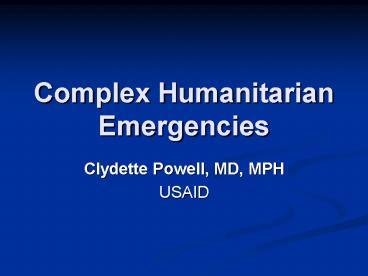Complex Humanitarian Emergencies - PowerPoint PPT Presentation
1 / 22
Title:
Complex Humanitarian Emergencies
Description:
... and politicians, along with UN agencies, World Food Program, arrive on the scene. CNN as well as local news media are setting up cameras, and reporters are ... – PowerPoint PPT presentation
Number of Views:891
Avg rating:5.0/5.0
Title: Complex Humanitarian Emergencies
1
Complex Humanitarian Emergencies
- Clydette Powell, MD, MPH
- USAID
2
Objectives
- Define and discuss the causes and phases of CHEs
- Understand the magnitude and measures of CHEs
- Use a case scenario to illustrate the reality and
optimum approaches to addressing CHEs
3
Definition of CHE
- CHE Human disaster that occurs during and
follows war and civil strife - Inciting event natural or man-made
- Characterized by displacement
- Loss of existing societal infrastructure
- Concerns for personal security
- 90 of war related mortality among civilian
non-combatants
4
Refugees and IDPs
- Flight across border (R) or within border (IDP)
- 14 million refugees
- 15 20 million IDPs
- UN and international protections vary
- Degree of difficulty in assistance
5
Phases of CHEs
- Acute (early) emergency 0 1 month
- Late or recovery 1 -6 months
- Rehabilitation and development 6 or more months
- Measure of severity depends on magnitude and
vulnerability of population - CMR number of deaths per 10,000 per day
6
Scenario
- Recent political changes with ongoing instability
- Drought and early famine
- Aggressive land reform with massive displacement
of people (IDPs) - Excellent health care system on sharp decline,
with drop in trust by public - Public health services characterized by patchy
coverage (eg., EPI)
7
- Rapid inflation, increasing unemployment
- Out-migration of health care professionals
- Disease outbreaks
- HIV on rise (1 in 3 persons) and TB incidence
increasing - Poor recognition of disease or means of
treatment poor coping skills - Increasing urban migration
8
YOU in the scenario
- You are a public health director of a rural
health clinic with limited facilities - Over the following two days, 10,000 exhausted
IDPs arrive in your area - Included in these are women and children and
people of different ethnic groups (known to be at
odds with one another) - District authorities have come asking for your
help.
9
Question 1
- What are your priorities, given the situation?
10
Lesson 1 - Coordination
- Before jumping to health solutions or any needs,
build a team - Have clear authority structure for delegation and
coordination - Communicate clearly and succinctly
- Have a camp manager
- Designate a reporter
11
Question 2
- Now that you have your team, what needs for this
population must you consider and in what
sequence?
12
Priority needs
- Food
- Water and sanitation
- Shelter
- Identification of vulnerable populations
- Appropriate health interventions for these
populations for example - Immunizations
- Nutritional assessment (e.g., MUAC)
13
Lesson 2
- Keep first things first
- Keep the big picture in mind (30,000 foot view)
- Collect only the data you need
- Be watchful for disease outbreaks for rapid
response - Maintain nutritional surveillance
- Monitor security and safety conditions
14
Day 3
- Government officials and politicians, along with
UN agencies, World Food Program, arrive on the
scene - CNN as well as local news media are setting up
cameras, and reporters are swarming the camp
perimeter
15
Question 3
- How do you handle the new arrivals?
16
Lesson 3 - Communication
- One designated camp reporter
- Daily updates and sound bites
- Data driven, not sensationalistic or speculative
- No opinions offered
- Do not get drawn into criticisms
- If answer not known, offer to get back to person
with question - Remember journalists are never off duty
17
Communication (contd)
- Be aware of UN politics
- Respect national politicians and the process
- Be aware of hidden agendas, confusing or
overlapping mandates - Keep in mind historical context
- Anticipate your comparative advantage and whether
you will stay engaged in the process or withdraw
at some point
18
Two Weeks Later.
- The army arrives to contain both the situation
and the IDPs, who are regarded as a threat to
local and national security. You are told that
the army is there for your safety and security,
but their presence limits your access to the camp
and curfew is put in place.
19
Question 4
- How do you respond to this new development in the
second week, especially in light of large and
expanding health needs and ongoing health
services? - Does the composition of your health staff modify,
or mitigate, your approach ?
20
Lesson 4
- Use low tech interventions
- Recruit among the camp population
- Anticipate from the start your exit plan,
contingencies, potential scenarios different from
the one at the beginning. - Attempt to promote ongoing dialogue between the
camp and local population
21
Resources
- www.reliefweb.org
- UN High Commissioner for Refugees for Human
Rights - International Committee of the Red Cross
- Medecins sans Frontieres
- Office for Coordination of Humanitarian Affairs
- FEWSNET
- Universal Declaration of Human Rights
- International Law of Human Rights
- USAID - Office of Foreign Disaster Assistance
and Office of Transition Initiatives - DOS - Population Refugees and Migration
22
Thank you!































